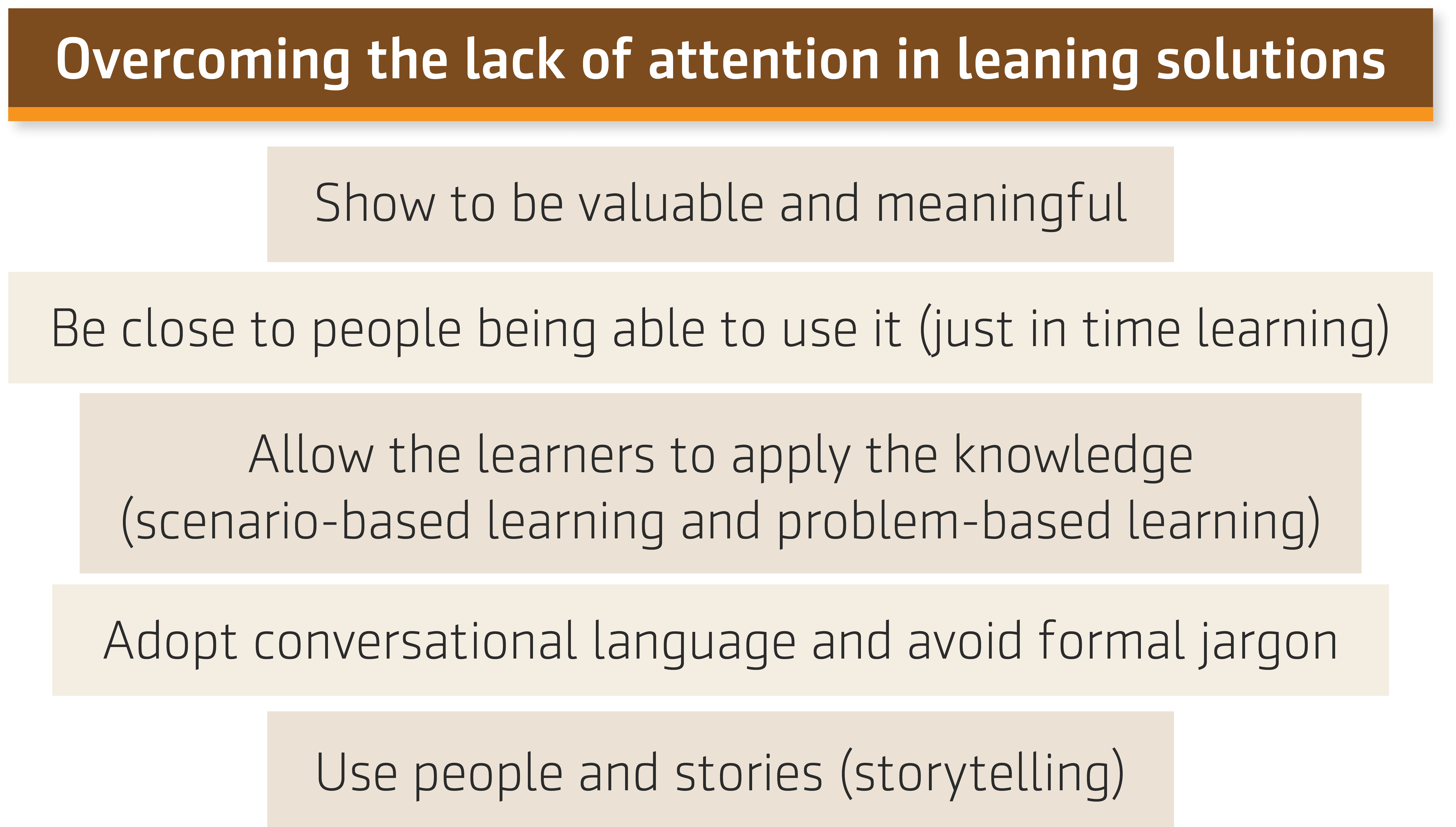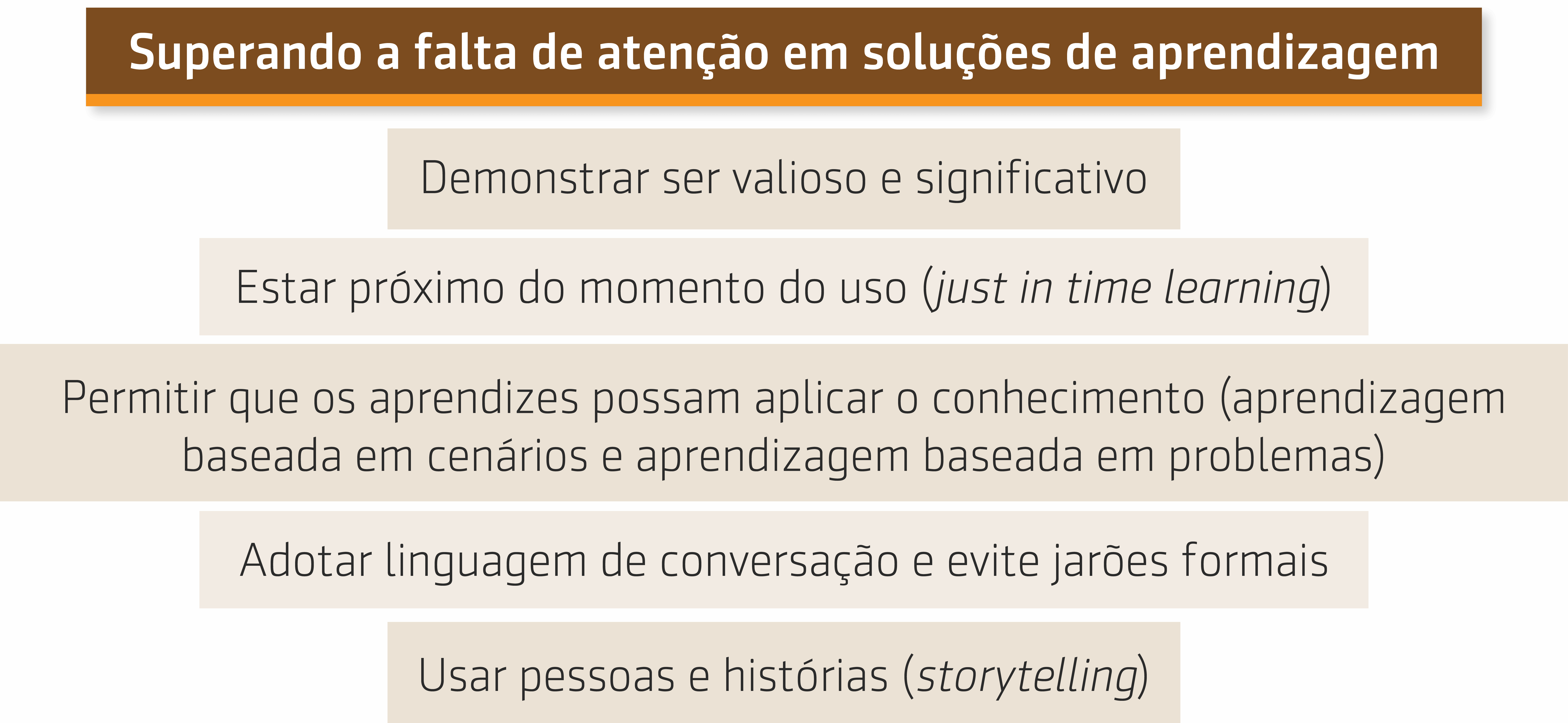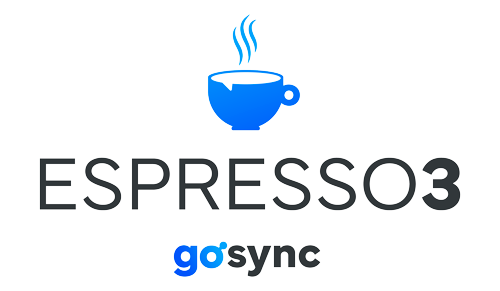We are back and my next guest is Julie Dirksen author of the book Design For How People Learn, and we’ll discuss here the importance of the attention and memory in our solutions.
I’m Wagner Cassimiro and this is the Espresso3.
Hi Julie!
Hi there!
What’s the problem regarding attention and memory in learning solutions?
There’s a couple of issues going on.
One is, there’s this belief that everybody’s attention span is getting so very, very short and that we have to make all learning experiences extremely short. The truth is, people will pay attention if they find it valuable to them. So, if it’s valuable, or meaningful, or helps them solve a problem, most people don’t have difficulty allocating attention.
If people want to pay attention they can pay attention for as long as they need to. People can watch long movies, or TV shows, or things for as long as they want to, because they actually want to pay attention to that.
But a lot of times we’re asking to pay attention to things that they can’t use right away. Boring stuff that they can’t use right away. That’s a much harder thing for people to allocate attention to, because they know that it’s not going to be relevant for a long time. They are fighting a lot of natural cues that tell them that’s not that important and try to force themselves to pay attention, but people find that very difficult.
Could you share some of the top recommendations to overcome the problems with that?
Yes! Absolutely!
If you can get the learning experience to be close to people being able to use it, it’s much easier for people to pay attention. One strategy is to use just in time learning, where you move the learning experience close to the time of use. So, people need to figure out how to fix a problem with their printer, they can just pull up a video and learn how to fix the problem of their printer and keep going.
YouTube is full of things that people use on the just in time basis, and they don’t have any trouble paying attention to those.
Sometimes that’s not possible. Sometimes the learning has to happen a long time before the point of use and what you can do in those situations is, you can make sure that the learning experience itself allows them to apply the knowledge. Because the reward for getting to learn something is getting to use it and that you can use it immediately even if it’s just part of the learning experience, it’s much easier for people to pay attention.
So, using scenario–based learning, or problem–based learning, where they can do something right away with the knowledge, makes it easier to pay attention. Also, things like, using conversational language and not a lot of formal jargon, or using people or stories, those are all things that will help, because those act as cues to the learner that are like “oh! I should pay attention to this”, or it won’t be hard to pay attention to it and they can allocate their attention more easily.
Are those tips universal or they are more applied to some kind of format?
It depends. Surely things like stories, problem–based learning, scenarios can be applied in any media. It doesn’t matter if it’s classroom, or online. Obviously, you wouldn’t use a lot of scenarios in a just in time learning environment, because people don’t earn interest in your story, then they have their own story and they just want the resource to help them.
So, when it’s learning where somebody isn’t going be able to use it for a long time, you would invest in things like stories and scenarios. If it’s learning where they are going to be able to use it immediately, then you just want to give them the information so that they can keep going.
Thank you!
Yes! Absolutely!

TRADUÇÃO
Superando a falta de atenção em soluções de aprendizagem – ATD Conference, 2019
Estamos de volta e minha próxima convidada é Julie Dirksen, autora do livro “Design For How People Learn“, e discutiremos aqui a importância da atenção e da memória em nossas soluções.
Eu sou Wagner Cassimiro e este é o Espresso3.
Oi Julie!
Olá!
Qual é o problema de atenção e memória nas soluções de aprendizagem?
Há alguns problemas acontecendo.
Uma é a crença de que a atenção de todos está ficando muito, muito curta e que temos que tornar todas as experiências de aprendizagem extremamente curtas. A verdade é que as pessoas prestarão atenção se acharem valioso para elas. Então, se é valioso ou significativo, ou ajuda a resolver um problema, a maioria das pessoas não tem dificuldade em alocar atenção.
Se as pessoas quiserem prestar atenção, podem prestar atenção pelo tempo que precisarem. As pessoas podem assistir a filmes longos, programas de TV ou coisas pelo tempo que quiserem, porque na verdade querem prestar atenção a isso.
Mas muitas vezes estamos pedindo para prestar atenção em coisas que eles não podem usar imediatamente. Coisas chatas que eles não podem usar imediatamente. É muito mais difícil para as pessoas alocar atenção, porque sabem que isso não será relevante por muito tempo. Eles estão lutando com muitas dicas naturais que dizem que isso não é tão importante e tentam se forçar a prestar atenção, mas as pessoas acham isso muito difícil.
Você poderia compartilhar algumas das principais recomendações para superar os problemas com isso?
Sim! Sem dúvida!
Se você conseguir que a experiência de aprendizagem seja próxima das pessoas poderem usá-la, é muito mais fácil para prestarem atenção. Uma estratégia é usar a aprendizagem just in time, onde você move a experiência de aprendizagem para perto do momento de uso. Então, as pessoas precisam descobrir como consertar um problema com sua impressora, eles podem simplesmente puxar um vídeo e aprender como consertar o problema de sua impressora e continuar.
O YouTube está cheio de coisas que as pessoas usam como just in time, e elas não têm nenhum problema em prestar atenção a elas.
Às vezes isso não é possível. Às vezes a aprendizagem tem que acontecer muito tempo antes do momento de uso e o que você pode fazer nessas situações é, você pode garantir que a própria experiência de aprendizagem permita que eles apliquem o conhecimento. Pois a recompensa de aprender algo é usá-lo e que você pode usá-lo imediatamente, mesmo que seja apenas parte da experiência de aprendizagem, é muito mais fácil para as pessoas prestarem atenção.
Assim, usando a aprendizagem baseada em cenários ou a aprendizagem baseada em problemas, onde eles podem fazer algo imediatamente com o conhecimento, fica mais fácil prestar atenção. Além disso, coisas como usar linguagem de conversação e não usar muitos jargões formais, ou usar pessoas ou histórias, essas são todas as coisas que ajudarão, porque elas funcionam como sugestões para o aprendiz que são como “oh! Eu devo prestar atenção nisso”, ou não será difícil prestar atenção nisso e eles podem alocar sua atenção mais facilmente.
Essas dicas são universais? Ou são mais aplicadas a algum tipo de formato?
Depende. Certamente, coisas como histórias, aprendizagem baseada em problemas, cenários, podem ser aplicados em qualquer meio. Não importa se é sala de aula ou online. Obviamente, você não usaria muitos cenários em um ambiente de aprendizagem just–in-time, porque as pessoas não se interessam na sua história, e elas têm sua própria história e só querem que o recurso as ajude.
Então, quando a aprendizagem é onde alguém não vai poder usá-la por um longo tempo, você investe em coisas como histórias e cenários. Se estiver aprendendo onde eles serão capazes de usá-lo imediatamente, então você só quer dar-lhes a informação para que eles possam continuar.
Obrigado!
Sim! Sem dúvida!

